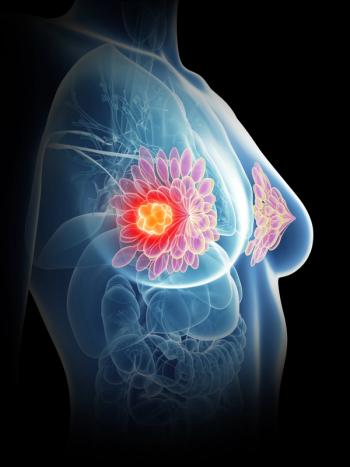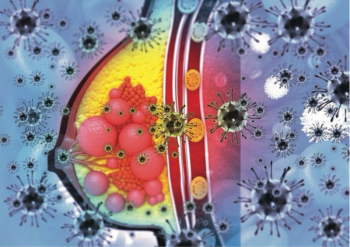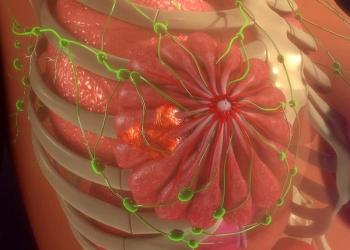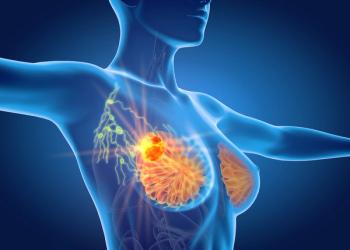
- ONCOLOGY Vol 25 No 10
- Volume 25
- Issue 10
What Are Safe Margins of Resection for Invasive and In Situ Breast Cancer?
The safety and efficacy of breast-conserving therapy (BCT) for women with early-stage breast cancer are well established. BCT entails wide excision of the tumor and appropriate nodal evaluation, followed by radiation therapy to the breast.
Adequate surgical margins in breast-conserving surgery are an important predictor of local recurrence (LR) rates. The definition of tumor-free margins in National Surgical Adjuvant Breast and Bowel Project (NSABP) trials requires that tumor cells do not touch ink, but subsequent retrospective single-institution studies have suggested that wider margins confer greater protection against LR. Particularly wide margins have been proposed for ductal carcinoma in situ. However, wider margin requirements lead to higher re-excision rates, with attendant economic, psychological, and cosmetic costs, and perhaps increased mastectomy rates. Juxtaposed against these concerns about optimal margin width, a meta-analysis of clinical trials has demonstrated the survival value of minimizing LR. We are therefore at a juncture where a reduction of LR may be achieved by tumor resection with wide margins, but data regarding optimal margin width are conflicting and the risk/benefit balance of tumorectomy with wide margins has not been demonstrated. A randomized trial of re-excision for close margins inserted into trials of systemic therapy could be considered but seems unlikely. Alternatively, detailed longitudinal data need to balance the value and the cost of wide margins. Until better data are available, the desirable margin width will vary depending on individual circumstances, including age, histology, and patient preference.
The safety and efficacy of breast-conserving therapy (BCT) for women with early-stage breast cancer are well established.[1,2] BCT entails wide excision of the tumor and appropriate nodal evaluation, followed by radiation therapy to the breast. There is broad agreement that successful breast conservation requires complete tumor excision, commonly described as a "tumor-free" or "negative" margin of resection, but the definition of a negative margin is controversial. Opinions range from the original National Surgical Adjuvant Breast and Bowel Project (NSABP) definition of "no ink on tumor," to a recommended width of 10 mm or more. A widely held position based on single-institution retrospective data is that a mandatory minimum distance between ink and tumor is necessary for good local control, but the margin width is debated. A commonly accepted definition of adequate margins requires a 2-mm distance between ink and tumor.
Randomized Trials, Resection Margins, and Recurrence in Invasive Breast Cancer
The original definition of a negative margin proposed by the NSABP was the absence of tumor cells at the ink, and subsequent NSABP studies follow this simple rule. The landmark NSABP study of breast conservation involved 1851 patients; the positive margin rate was 6.8%, and with a 20-year follow-up the in-breast tumor recurrence rate was 14.2%.[1] Importantly, there was no attempt to distinguish new primary tumors from true recurrences, and given the 20-year follow-up interval, there was undoubtedly a substantial proportion of new primaries among the 14.2% of women who experienced ipsilateral breast tumor recurrence (IBTR). According to recent studies that have tried to distinguish between these events, the new primary cancer rate at 10 years may account for up to half of all observed IBTRs.[2,3] If one estimates the true recurrence rate in the NSABP B-06 trial based on this estimate, then true local recurrences occurred in about 7% of women. Other randomized trials of breast conservation are summarized in
Nonrandomized Data on Resection Margins and Recurrence in Invasive Breast Cancer
TABLE 1
Summary of Randomized Trials of Breast Conservation
More recently, NSABP investigators have published two separate analyses of local recurrence, distant disease, and breast cancer mortality, using pooled data from adjuvant therapy trials subsequent to B-06. One report dealt with patients with node-negative breast cancer and included a total of 3,799 women who participated in five NSABP protocols and underwent BCT with or without adjuvant systemic therapy.[4] Patients treated with adjuvant systemic therapy had a 12-year cumulative incidence of IBTR of 6.6%, with a 1.8% "other local recurrence" rate (oLRR, or regional nodal recurrence). Younger women had a significantly higher cumulative incidence of IBTR than did older women. In a similar pooled analysis of trials enrolling women with node-positive disease, the 10-year incidences of IBTR and oLRR were 8.7% and 6.0%, respectively. The time period over which these women were treated extends into the 1990s; and although NSABP protocols required only that tumor should not touch the margin ink, it is not known how individual NSABP surgeons applied this protocol definition, nor whether or not re-excisions were being performed at these institutions for margins less than 1 or 2 mm. Throughout the 1990s, several single-institution retrospective analyses designed to identify risk factors for local recurrence of breast cancer have examined the impact of wider resection margins on local control. In particular, much attention has been paid to the definition of a negative margin, with several studies showing that a minimum margin width of 1 or 2 mm or more was associated with reduced risk of local recurrence.[5-7] These studies described a lower recurrence rate than the B-06 study, albeit with substantially shorter follow-up durations. Subsequent single-institution studies have demonstrated a strong temporal effect on IBTR rates, with a significant decline in later time-periods[8,9]; although these declines are undoubtedly related to better radiological and pathological evaluation, and to boost radiotherapy and uniform use of systemic therapy, it is not possible to say what the contribution is of wider excisions and re-excisions. More recent, larger studies that examined margin status and recurrence rate are summarized in
Randomized Trial Data on Resection Margins and Recurrence in DCIS
TABLE 2
Retrospective Studies of Local Control Following Breast Conservation for Invasive Cancer, Reported Since 2000, With More Than 500 Patients per Study
Wapnir et al have recently reported on pooled data from patients participating in NSABP B-17 (testing excision alone vs excision with radiotherapy) and B-24 (testing excision with radiotherapy, with or without tamoxifen).Importantly, margin-positive patients were allowed to participate in B-24, and the free margin definition in both studies was "no ink on tumor." The 15-year outcomes were pooled and published recently, showing that IBTR rates in women treated with excision and radiation have climbed since the original reports; they are now 19.8% (B-17) and 16.6% (B-24) with radiation therapy alone, and a reduction to 13.2% is seen with the addition of tamoxifen in B-24.[12] The ductal carcinoma in situ (DCIS) trial by the European Organisation for Research and Treatment of Cancer (EORTC), using a similar margin definition, showed similar results, with a 10-year local recurrence rate of 15% in the radiated group. Thus long-term IBTR rates in prospective studies of DCIS tend to be somewhat higher in DCIS patients than in patients with invasive breast cancer when a similar margin threshold (no ink on tumor) is applied.
Nonrandomized Data on Resection Margins and Recurrence in DCIS
A meta-analysis of data from DCIS trials and observational studies that included patients treated with radiotherapy[13] has provided information on incremental margin width and local control. Positive margins are clearly associated with an increased risk of IBTR, but it appears that for DCIS (in contrast to invasive cancer) there is a significant trend towards greater benefit with margins of 2 mm or more that seems to plateau at a margin distance of 2 mm. Only a small number of patients have margins of 5 mm or more, however. These data contrast with reports by Silverstein and colleagues, who suggest that margins exceeding 10 mm are optimal for excision of DCIS. Since the interval between 1 mm and 10 mm in their study is not broken out into smaller intervals, one cannot determine whether the 2-mm threshold is also significant in their experience.[14] Other observational studies also suggest that for DCIS, a close margin may increase the hazard of local recurrence,[15] and therefore it may be reasonable to define the optimal free margin for DCIS as a width of 2 mm.
Methods for Minimizing Residual Tumor
TABLE 3
DCIS IBTR Rates Relative to Margin Width in Patients Receiving Radiotherapy
Tumor-free margins are the agreed-upon objective indicator of a minimal residual tumor burden following wide excision of a breast cancer, but clearly are only a surrogate marker of good local control. Free margins do not ensure freedom from local recurrence, even when radiotherapy is used. As the best available surrogate, however, obtaining negative margins remains the gold standard, and several techniques have been tried to minimize residual tumor and the need for re-excision of positive margins (however they are defined). Intraoperative frozen section or touch prep has been reported to reduce the need for re-excision procedures but has not been widely adopted because it is resource-intensive and does not perform well for the most common margin problem, namely DCIS at or near the margin.[16] Intraoperative touch-prep of margins in one study of 398 patients was associated with a positive predictive value of 73.6%,[17] whereas in another study of 30 patients, its positive predictive value was 21%[18]; the technique clearly requires significant experience to implement, and at best will provide incremental improvement over present re-excision rates. Frozen-section examination of margins was evaluated in a Scandinavian study, which found that 16% of 186 patients required re-excision for positive margins despite the use of frozen section.[19] A prior American study showed similar results, with false-negative frozen section findings in 19% of 97 patients.[16] Since re-excision rates of under 20% can be regularly achieved without frozen section, the value of this technique is not clear.
There is wide agreement that orienting sutures and multicolored inks should be used to designate the various tumorectomy surfaces, but the translation of intraoperative orientation to the surgical pathology gross room is challenging, given the propensity of the specimen to flatten out and "change shape" by the time it is grossly examined and sectioned. A solution to this problem may involve the technique of "cavity shaves," in which thin samples of breast tissue from the resectional cavity are submitted separately; if these are positive for tumor they represent, for the surgeon, more interpretable data regarding the location of a positive margin. Cavity shavings are increasingly accepted as a valid and reproducible way of decreasing re-excision rates. Huston et al found that complete resection of four to six additional margins during the initial lumpectomy decreased the reoperation rate but was associated with higher tissue volumes.[20] In another study, a higher rate of negative microscopic margins and a lower reoperation rate were found with the use of cavity shaves, with lower volumes of excised breast, improved patient satisfaction, and decreased cost.[21] Jacobson et al examined records of 125 patients in a retrospective study and found excision of additional shaved margins at the original procedure reduced re-operations by 48%.[22] While the volume of resected tissue may be increased by use of routine cavity shaves, as is the cost of pathological evaluation, the decreased rates of re-excision, with its attendant costs, are likely to result in an overall advantage for this technique. Data on long-term outcomes have not been reported.
The ability to perform real-time molecular imaging analysis of margins during surgery would clearly be a significant advance; several groups have engaged in this effort, with encouraging reports of preliminary data.[23,24] Further development of such techniques promises to lead to a point at which accurate intraoperative margin evaluation may be possible and may even be combined with therapeutic interventions, using techniques such as photodynamic therapy.
Discussion
The optimal margin distance for breast cancer excision remains an area of controversy, particularly in the setting of renewed interest in maximizing local control. Although NSABP studies have established that "no ink on tumor" is the minimum required for acceptable local control, this does not answer the question of what minimal distance is required for optimal local control, since individual NSABP surgeons and centers may have applied more stringent criteria for their patients. Surveys of radiation oncologists in North America and in Europe and of surgeons in the United States have shown that there is no consensus regarding optimal margins of excision. Among those surveyed, only 11% of US surgeons, 46% of North American radiation oncologists, and 28% of European radiation oncologists endorsed negative margins as "no tumor at the ink."[23,24] Most surgeons do not perform intraoperative margin analysis. Almost half of the surveyed surgeons (48%) examine the margins grossly with a pathologist. Re-excision decision-making varies greatly: 57% of surgeons would never re-excise for a positive deep margin, but 53% would always re-excise for a positive anterior margin. Jacobsen et al found that 15% of surgeons accept any negative margin, 28% would accept a 1-mm negative margin, 50% would accept a 2-mm negative margin, 12% would accept a 5-mm negative margin, and 3% would accept a 10-mm negative margin.[22] This wide variation is reflected in reported re-excision rates, which range from 10% to 50%.
Wide margin consequences
TABLE 4
Impact of Margin Width Definition on Positive Margin Rates
An unnecessarily wide standard for tumor resection margins results in high positive margin rates, and obligates the surgeon to re-operate in order to obtain the required margins.
The cost of re-operation for breast cancer
Additional surgery takes a significant emotional toll on the patient, a factor that has not received any attention in the surgical literature. Recent data document the fact that a finding of positive margins at first excision may lead to the decision to perform a mastectomy[26] or even bilateral mastectomy.[27] In women who adhere to the plan for breast conservation, it compromises the final cosmetic outcomes, with the potential to profoundly affect self-esteem, body image, and sexuality. The economic cost has not been evaluated to date, although it includes the costs of the re-excision and conversion to mastectomy, and possibly the cost of reconstruction. The perceived benefit of wide margins of resection is also driving use of "oncoplastic" techniques of breast tumor resection, increasing costs of surgery not only on the ipsilateral side, but also on the contralateral side, since many of these women then need a reduction of the contralateral breast.
Conclusion
A consensus about the definition of negative margins is needed, with data-based guidelines for re-excision parameters. A randomized trial devoted to this issue is unlikely to arouse enthusiasm. However, if one considers this issue not only from the perspective of demonstrating a possible benefit of wider excision (perhaps in high-risk subsets such as young women and those with triple-negative tumors), but also from the vantage point of assessing harm from unnecessary intervention, then the rationale for such a study is quite strong. A possible design would embed the margin question into one or more large systemic therapy trials, and randomize women with margins of under 2 mm to re-excision or not. Additionally, margin width is not captured in large national databases such as Surveillance, Epidemiology, and End Results (SEER), the National Cancer Data Base (NCDB), or the National Comprehensive Cancer Network (NCCN) database. Collection of margin width data along with the number of surgical procedures would allow a better assessment of the impact of margin width standards on a range of outcomes, and would enable comparative-effectiveness research in this area.
Finally, continued research is needed into better techniques for real-time margin sampling. Improvements in this area, we would hope, could increase the accuracy of our resections, obviate the need for re-excision, and improve outcomes with a single surgical procedure.
Financial Disclosure:The authors have no significant financial interest or other relationship with the manufacturers of any products or providers of any service mentioned in this article.
References:
References
1. Fisher B, Anderson S, Bryant J, et al. Twenty-year follow-up of a randomized trial comparing total mastectomy, lumpectomy, and lumpectomy plus irradiation for the treatment of invasive breast cancer. N Engl J Med. 2002;347:1233-41.
2. Yi M, Buchholz TA, Meric-Bernstam F, et al. Classification of ipsilateral breast tumor recurrences after breast conservation therapy can predict patient prognosis and facilitate treatment planning. Ann Surg. 2011;253:572-9.
3. Panet-Raymond V, Truong PT, Alexander C, et al. Clinicopathologic factors of the recurrent tumor predict outcome in patients with ipsilateral breast tumor recurrence. Cancer. 2011;117:2035-43.
4. Anderson SJ, Wapnir I, Dignam JJ, et al. Prognosis after ipsilateral breast tumor recurrence and locoregional recurrences in patients treated by breast-conserving therapy in five National Surgical Adjuvant Breast and Bowel Project protocols of node-negative breast cancer. J Clin Oncol. 2009;27:2466-73.
5. Smitt MC, Nowels KW, Zdeblick MJ, et al. The importance of the lumpectomy surgical margin status in long-term results of breast conservation. Cancer. 1995;76:259-67.
6. Freedman G, Fowble B, Hanlon A, et al. Patients with early stage invasive cancer with close or positive margins treated with conservative surgery and radiation have an increased risk of breast recurrence that is delayed by adjuvant systemic therapy. Int J Radiat Oncol Biol Phys. 1999;44:1005-15.
7. Recht A, Come SE, Henderson IC, et al. The sequencing of chemotherapy and radiation therapy after conservative surgery for early-stage breast cancer. N Engl J Med. 1996;334:1356-61.
8. Pass H, Vicini FA, Kestin LL, et al. Changes in management techniques and patterns of disease recurrence over time in patients with breast carcinoma treated with breast-conserving therapy at a single institution. Cancer. 2004;101:713-20.
9. Cabioglu N, Hunt KK, Buchholz TA, et al. Improving local control with breast-conserving therapy: a 27-year single-institution experience. Cancer. 2005;104:20-9.
10. Lupe K, Truong PT, Alexander C, et al. Subsets of women with close or positive margins after breast-conserving surgery with high local recurrence risk despite breast plus boost radiotherapy. Int J Radiat Oncol Biol Phys. Apr 20, 2011 [Epub ahead of print].
11. Groot G, Rees H, Pahwa P, et al. Predicting local recurrence following breast-conserving therapy for early stage breast cancer: the significance of a narrow (
12. Wapnir IL, Dignam JJ, Fisher B, et al. Long-term outcomes of invasive ipsilateral breast tumor recurrences after lumpectomy in NSABP B-17 and B-24 randomized clinical trials for DCIS. J Natl Cancer Inst. 2011;103:478-88.
13. Dunne C, Burke JP, Morrow M, Kell MR. Effect of margin status on local recurrence after breast conservation and radiation therapy for ductal carcinoma in situ. J Clin Oncol. 2009;27:1615-20.
14. MacDonald HR, Silverstein MJ, Mabry H, et al. Local control in ductal carcinoma in situ treated by excision alone: incremental benefit of larger margins. Am J Surg 2005;190:521-5.
15. Rudloff U, Jacks LM, Goldberg JI, et al. Nomogram for predicting the risk of local recurrence after breast-conserving surgery for ductal carcinoma in situ. J Clin Oncol. 2010;28:3762-9.
16. Cendan JC, Coco D, Copeland EM, III. Accuracy of intraoperative frozen-section analysis of breast cancer lumpectomy-bed margins. J Am Coll Surg. 2005;
201:194-8.
17. D’Halluin F, Tas P, Rouquette S, et al. Intra-operative touch preparation cytology following lumpectomy for breast cancer: a series of 400 procedures. Breast. 2009;18:248-53.
18. Valdes EK, Boolbol SK, Cohen JM, Feldman SM. Intra-operative touch preparation cytology: does it have a role in re-excision lumpectomy? Ann Surg Oncol. 2007;14:1045-50.
19. Dener C, Inan A, Sen M, Demirci S. Interoperative frozen section for margin assessment in breast conserving energy. Scand J Surg. 2009;98:34-40.
20. Huston TL, Pigalarga R, Osborne MP, Tousimis E. The influence of additional surgical margins on the total specimen volume excised and the reoperative rate after breast-conserving surgery. Am J Surg. 2006;192:509-12.
21. Rizzo M, Iyengar R, Gabram SG, et al. The effects of additional tumor cavity sampling at the time of breast-conserving surgery on final margin status, volume of resection, and pathologist workload. Ann Surg Oncol. 2010;17:228-34.
22. Jacobson AF, Asad J, Boolbol SK, et al. Do additional shaved margins at the time of lumpectomy eliminate the need for re-excision? Am J Surg. 2008;196:556-8.
23. Pleijhuis RG, Langhout GC, Helfrich W, et al. Near-infrared fluorescence (NIRF) imaging in breast-conserving surgery: assessing intraoperative techniques in tissue-simulating breast phantoms. Eur J Surg Oncol. 2011;37:32-9.
24. Zhou C, Cohen DW, Wang Y, et al. Integrated optical coherence tomography and microscopy for ex vivo multiscale evaluation of human breast tissues. Cancer Res. 2010;70:10071-9.
25. Singletary SE. Surgical margins in patients with early-stage breast cancer treated with breast conservation therapy. Am J Surg. 2002;184:383-93.
26. Morrow M, Jagsi R, Alderman AK, et al. Surgeon recommendations and receipt of mastectomy for treatment of breast cancer. JAMA. 2009;302:1551-6.
27. King TA, Sakr R, Patil S, et al. Clinical management factors contribute to the decision for contralateral prophylactic mastectomy. J Clin Oncol. 2011;29:2158-64.
28. Park CC, Mitsumori M, Nixon A, et al. Outcome at 8 years after breast-conserving surgery and radiation therapy for invasive breast cancer: influence of margin status and systemic therapy on local recurrence. J Clin Oncol. 2000;18:1668-75.
29. Gibson GR, Lesnikoski BA, Yoo J, et al. A comparison of ink-directed and traditional whole-cavity re-excision for breast lumpectomy specimens with positive margins. Ann Surg Oncol. 2001;8:693-704.
30. Aziz D, Rawlinson E, Narod SA, et al. The role of reexcision for positive margins in optimizing local disease control after breast-conserving surgery for cancer. Breast J. 2006;12:331-7.
31. Kreike B, Hart AA, van de Velde T, et al. Continuing risk of ipsilateral breast relapse after breast-conserving therapy at long-term follow-up. Int J Radiat Oncol Biol Phys. 2008;71:1014-21.
32. Hewes JC, Imkampe A, Haji A, Bates T. Importance of routine cavity sampling in breast conservation surgery. Br J Surg. 2009;96:47-53.
33. Julien JP, Bijker N, Fentiman IS, et al. Radiotherapy in breast-conserving treatment for ductal carcinoma in situ: first results of the EORTC randomised phase III trial 10853. EORTC Breast Cancer Cooperative Group and EORTC Radiotherapy Group. Lancet. 2000;355:528-33.
34. Chagpar AB, Martin RC 2nd, Hagendoorn LJ, et al. Lumpectomy margins are affected by tumor size and histologic subtype but not by biopsy technique. Am J Surg. 2004;188:399-402.
35. Dillon MF, Hill AD, Quinn CM, et al. A pathologic assessment of adequate margin status in breast-conserving therapy. Ann Surg Oncol. 2006;13:333-9.
36. Smitt MC, Horst K. Association of clinical and pathologic variables with lumpectomy surgical margin status after preoperative diagnosis or excisional biopsy of invasive breast cancer. Ann Surg Oncol. 2007;14:1040-4.
37. Schiller DE, Le LW, Cho BC, et al. Factors associated with negative margins of lumpectomy specimen: potential use in selecting patients for intraoperative radiotherapy. Ann Surg Oncol. 2008;15:833-42.
38. Waljee JF, Hu ES, Newman LA, Alderman AK. Predictors of re-excision among women undergoing breast-conserving surgery for cancer. Ann Surg Oncol. 2008;15:1297-303.
39. Sabel MS, Rogers K, Griffith K, et al: Residual disease after re-excision lumpectomy for close margins. J Surg Oncol. 2009;99:99-103.
Articles in this issue
over 14 years ago
Cytoreductive Surgery for Advanced Ovarian Cancer: Quo Vadis?over 14 years ago
Bladder Cancer: Imperatives for Personalized Medicineover 14 years ago
Cancer-Related TTP and Considerations of Plasma Exchangeover 14 years ago
Controversies in the Management of Advanced Ovarian Cancerover 14 years ago
Ginkgo (Ginkgo biloba)Newsletter
Stay up to date on recent advances in the multidisciplinary approach to cancer.

















































































